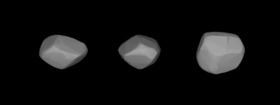Discovered by Ernst Wilhelm Tempel Minor planet category Main belt Semi-major axis 401.580 Gm (2.684 AU) Discovered 4 March 1861 Discovery site Marseille Observatory | Discovery date March 4, 1861 Perihelion 351.784 Gm (2.352 AU) Eccentricity 0.124 Orbits Sun Discoverer Wilhelm Tempel Aphelion 451.375 | |
 | ||
Similar Wilhelm Tempel discoveries, Other celestial objects | ||
64 Angelina is a medium-sized main belt E-type asteroid discovered in 1861. It is an unusually bright form of E-type asteroid.
Contents
Discovery and naming
Angelina was discovered on March 4, 1861, by a prolific comet discoverer, E. W. Tempel, observing from Marseilles, France. It was the first of his five asteroid discoveries.
Angelina's name caused some controversy. It was chosen by Benjamin Valz, director of the Marseilles Observatory, in honour of the astronomical station of that name operated by Baron Franz Xaver von Zach on the mountains above the city. At the time, asteroids were supposed to receive names from classical mythology, and several astronomers protested the choice. Tempel noted that if the second 'n' were removed, the complaints would be satisfied (referring to Angelia, a minor Greek deity). However, Valz's choice stayed.
Physical characteristics
Angelina is an uncommon form of E-type asteroid; it is the third largest E-type after 44 Nysa and 55 Pandora, and has an exceptionally high albedo. As of 1991, it is thought to have an average radius of about 30 kilometers (19 mi). Back when asteroids were generally assumed to have low albedos, Angelina was thought to be the largest of this class, but modern research has shown that its diameter is only a quarter of what was previously assumed, an error caused by its exceptional brightness. Traditional calculations had suggested that since Angelina has an absolute magnitude of 7.7 and an albedo of 0.15, its diameter would have been around 100 km. However, a 2004 occultation showed a cross-sectional profile of only 48x53 km. Angelina was observed by Arecibo radar in January 2010.
